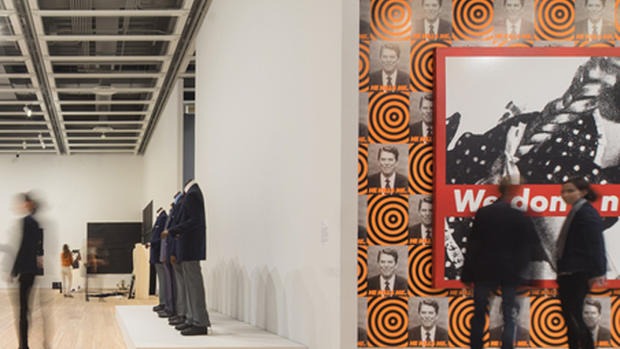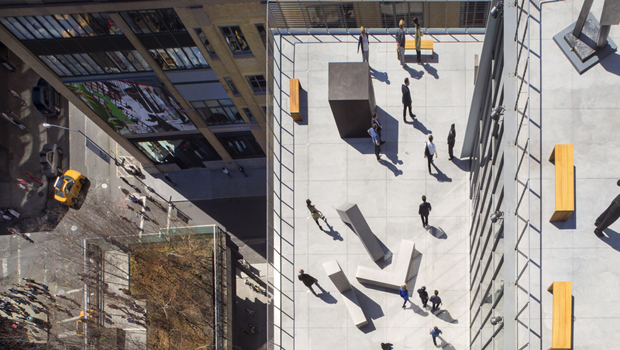A vibrant new home for American art
The Whitney Museum is a treasure trove of American art, which first opened its doors 101 years ago. Now, it has opened its doors in a brand-new building. Norah O'Donnell of "CBS This Morning" gives us a tour:
Sitting along the edge of the Hudson River in New York City, the new home of the Whitney Museum of American Art looks ready to set sail -- packed with a cargo of Rothkos, Pollocks, Warhols and Hoppers.
"Our greatest specialty is that we focus on art of the United States," said Adam Weinberg, the director of the Whitney Museum. "That could be art made by an artist from abroad, working in the United States. It could be made an artist from the United States working abroad. So it's America in its broadest sense. But it is art that somehow has a connection to this country."
Weinberg oversaw the Whitney's move from its home of 49 years on the Upper East Side of Manhattan to the trendy Meatpacking District downtown
Did they outgrow their old space? "I always say it's a little bit like a wonderful suit that you have. It's just a fantastic thing, but it's still too small," said Weinberg. "When the Whitney originally opened in 1966, we had 2,000 works of art. Today we have 22,000 works of art in the collection."
Famed Italian Architect Renzo Piano was enlisted to design the $422 million Whitney reboot. The ceilings are one aspect of the building that jumps out.
"It's a ceiling that is made in all the flexible -- in made -- in all made in order to put the lighting or the sound where you needed to put light and sound. And also to -- to hold and to suspend the things. And the piece of art or whatever you need," Piano said. This is a very old dream of architects, the idea that you make a place for art that is flexible, where the artist comes and he can actually use, like, a factory."
Piano has designed a true artists' museum. There are approximately 50,000 square feet of indoor gallery space, and 13,000 square feet of outdoor space for artists to use. And the new Whitney is multifunctional -- adaptable to whatever art installations may require in terms of space, lighting or sound.
Artist Mary Heilman's installation of multicolored chairs is one of many site-specific works that the new Whitney is designed to accommodate.
"It's a dream come true to be an artist in the Whitney, and to have people sitting on my art is amazing," she told O'Donnell. "Usually museums just focus on the inside and the artwork in there, so this is a new kind of cultural idea, that the art is part of the whole world."
But some critics have not been so kind to the new design, calling it "ungainly," "a jumble," and "industrial."
"And this is typical," said Piano. "I expected that. I think you don't have to do what people expect you do to. ... There is no one artist in this collection that did what people expected him to do, or her to do. You know, you do what you feel. You do what the truth is for you."
"So how did you come up with the concept for this new museum?" asked O'Donnell.
"That was more easy because, you know, this part of the city is fundamentally where Whitney started from [a] long time ago," he replied.
The Whitney first opened its doors in 1914, in nearby Greenwich Village as the "Whitney Studio." It was originally just a simple gallery space for neglected American artists, founded by Gertrude Vanderbilt Whitney, of the famous Vanderbilt family. She was a sculptor and serious collector of American art.
"She never intended to build a museum," said Weinberg. "She actually offered her collection to the Met, but the Met wasn't interested. They didn't think American art was very interesting in the 1920s."
And so the Whitney was born. "And it was her baby, the museum. It was an incubator for artists. It was a chance for artists to show what else they were doing at a time when nobody was interested in contemporary American art," Weinberg said.
Artists like Edward Hopper, George Bellows and Georgia O'Keeffe all found a home at the Whitney before they were wanted anywhere else.
And as the Whitney's collection grew, so did respect for American art ... so much so that former first lady Jackie Kennedy was at the opening of the last Whitney building in 1966.
And almost 50 years later, first lady Michelle Obama was there last week for the opening of the new Whitney.
In keeping with the Whitney's original mission, the inaugural exhibition is called "America Is Hard to See." It's a collection of well-known and not-so-well-known American artists, all mixed together as an ode to the country, and a welcome to the world.
When asked what he hoped people would find when they come here, Weinberg said: "I hope that people will see things that surprise them. I hope there are things that -- that move them. I hope that they have a feeling of moments of meditation and tranquility, but moments of great pleasure and senses of humor. I -- you know, that's the great thing about art is that it can be a lot of different things. And I hope that people can find a full range of experience at the Whitney."
For more info:
- The Whitney Museum of American Art, New York, N.Y.
- "America Is Hard to See" Exhibition, at the Whitney (runs through September 27)
- Follow the Whitney Museum on Twitter, Facebook, Instagram and YouTube



